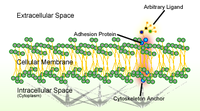
Photo from wikipedia
Peripheral arterial disease (PAD) is one of the most common manifestations of systemic atherosclerosis. The prevalence of unrecognized PAD is high, leading to a lack of opportunity to detect subjects… Click to show full abstract
Peripheral arterial disease (PAD) is one of the most common manifestations of systemic atherosclerosis. The prevalence of unrecognized PAD is high, leading to a lack of opportunity to detect subjects at a high risk for cardiovascular events. Inflammatory processes play an important role in the disease initiation as well as in the disease progression. Vascular cell adhesion molecule 1 (VCAM-1), a biomarker of endothelial dysfunction, appears to be an important mediator in inflammatory processes. Therefore, we hypothesized that in patients with PAD, circulating VCAM-1 might be elevated due to its function in mediating adhesion of immune cells to the vascular endothelium in the process of endothelial dysfunction and inflammation, and, therefore, applicable as a diagnostic biomarker. A total of 126 non-consecutive patients were enrolled in this study, of whom 51 patients had typical clinical manifestations of PAD and as controls 75 patients with no history of PAD or cardiovascular disease. All serum samples were obtained either during hospitalization or during out-patient visits and analyzed for VCAM-1 by the ELISA. Compared with controls, median levels of VCAM-1 were significantly elevated in patients suffering from PAD (953 vs. 1352 pg/ml; p < 0.001). Furthermore, VCAM-1 appeared to be highly discriminative for the detection of PAD (AUC = 0.76; CI 0.67–0.83). We could not observe dynamics related to increasing disease stages according to Rutherford classes in patients with apparent PAD. VCAM-1 was shown to be a potential discriminator and biomarker for the severity of systemic atherosclerosis. In a logistic regression analysis, VCAM-1 was robustly associated with the diagnosis of PAD, even after correction for clinically relevant cofounders (namely age, arterial hypertension, diabetes and LDL levels). Thusly, VCAM-1 might serve as a biomarker for PAD screening and detection.
Journal Title: Heart and Vessels
Year Published: 2018
Link to full text (if available)
Share on Social Media: Sign Up to like & get
recommendations!